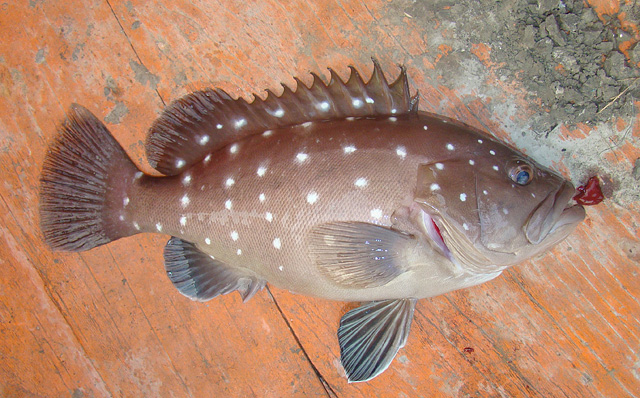| Epinephelidae (Groupers) |
| 122 cm TL (male/unsexed); max.weight: 30 kg; max. reported age: 27 years |
|
demersal; marine; depth range 30 - 525 m |
| Western Atlantic: Canada (Ref. 5951) to Massachusetts, USA to southern Brazil, including the Gulf of Mexico and the Caribbean. |
|
Dorsal spines (total): 11-11; Dorsal soft rays (total): 13-15; Anal spines: 3-3; Anal soft rays: 9-9. Distinguished by the following characteristics: Dark margin on spiny dorsal fin and dark saddle on caudal peduncle that extends below lateral line (Ref. 26938); juveniles with pale yellow caudal and pectoral fins; black saddle blotch on the caudal peduncle reaching below lateral line; depth of body contained 2.4-2.8 times in SL; head length 2.2-2.4 times in SL; convex interorbital area, width less than or subequal to eye diameter; enlarged serrae at angle of preopercle; distinctly convex upper edge of operculum; posterior nostrils 2-5 times larger than anterior nostrils (Ref. 89707). |
| Adults occur well offshore on rocky bottoms. Juveniles may be found inshore and are often reported from the northeastern coast of the U.S (Ref. 89707). Adults feed on fishes, gastropods, cephalopods, and brachyuran crustaceans (Ref. 5222). Valuable commercial food fish (Ref. 26938). |
|
Vulnerable (VU); Date assessed: 21 November 2016 (A2bd+4bd) Ref. (130435)
|
| harmless |
|
Ranges from Massachusetts to Texas. Commercially important stocks occur off the southeast coast of the U.S. (North Carolina to Georgia), Florida west coast, and lower Florida Keys(Ref. 5222). Percentage of males in the population off North and South Carolina appears to have decreased significantly, from 7-23% in the 1970s and 1980s to 1% in the 1990s and mean length of fish landed in the longline fishery has steadily decreased from 65-80 cm in the early 1980s to 50-60 cm in the mid-1990s (Ref. 45886). Also Ref. 276, 26340, 26938, 89707. |
Source and more info: www.fishbase.org. For personal, classroom, and other internal use only. Not for publication.

